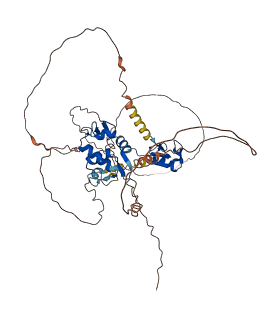Descriptions
Autoinhibitory domains (AIDs)
Target domain |
24-107 (SWIB/MDM2 domain) |
Relief mechanism |
Partner binding |
Assay |
|
Accessory elements
No accessory elements
Autoinhibited structure

Activated structure

1 structures for G1KGI8
| Entry ID | Method | Resolution | Chain | Position | Source |
|---|---|---|---|---|---|
| AF-G1KGI8-F1 | Predicted | AlphaFoldDB |
No variants for G1KGI8
| Variant ID(s) | Position | Change | Description | Diseaes Association | Provenance |
|---|---|---|---|---|---|
| No variants for G1KGI8 | |||||
No associated diseases with G1KGI8
4 regional properties for G1KGI8
| Type | Name | Position | InterPro Accession |
|---|---|---|---|
| domain | Protein kinase domain | 15 - 270 | IPR000719 |
| active_site | Serine/threonine-protein kinase, active site | 132 - 144 | IPR008271 |
| binding_site | Protein kinase, ATP binding site | 21 - 49 | IPR017441 |
| domain | Calcium/calmodulin-dependent protein kinase type 1B, catalytic domain | 11 - 287 | IPR042696 |
3 GO annotations of cellular component
| Name | Definition |
|---|---|
| nucleoplasm | That part of the nuclear content other than the chromosomes or the nucleolus. |
| nucleus | A membrane-bounded organelle of eukaryotic cells in which chromosomes are housed and replicated. In most cells, the nucleus contains all of the cell's chromosomes except the organellar chromosomes, and is the site of RNA synthesis and processing. In some species, or in specialized cell types, RNA metabolism or DNA replication may be absent. |
| transcription repressor complex | A protein complex that possesses activity that prevents or downregulates transcription. |
3 GO annotations of molecular function
| Name | Definition |
|---|---|
| enzyme binding | Binding to an enzyme, a protein with catalytic activity. |
| metal ion binding | Binding to a metal ion. |
| p53 binding | Binding to one of the p53 family of proteins. |
9 GO annotations of biological process
| Name | Definition |
|---|---|
| cellular response to hypoxia | Any process that results in a change in state or activity of a cell (in terms of movement, secretion, enzyme production, gene expression, etc.) as a result of a stimulus indicating lowered oxygen tension. Hypoxia, defined as a decline in O2 levels below normoxic levels of 20.8 - 20.95%, results in metabolic adaptation at both the cellular and organismal level. |
| DNA damage response, signal transduction by p53 class mediator | A cascade of processes induced by the cell cycle regulator phosphoprotein p53, or an equivalent protein, in response to the detection of DNA damage. |
| negative regulation of apoptotic process | Any process that stops, prevents, or reduces the frequency, rate or extent of cell death by apoptotic process. |
| negative regulation of protein catabolic process | Any process that stops, prevents or reduces the frequency, rate or extent of protein catabolic process. |
| negative regulation of transcription by RNA polymerase II | Any process that stops, prevents, or reduces the frequency, rate or extent of transcription mediated by RNA polymerase II. |
| protein stabilization | Any process involved in maintaining the structure and integrity of a protein and preventing it from degradation or aggregation. |
| protein-containing complex assembly | The aggregation, arrangement and bonding together of a set of macromolecules to form a protein-containing complex. |
| regulation of cell cycle | Any process that modulates the rate or extent of progression through the cell cycle. |
| regulation of transcription by RNA polymerase II | Any process that modulates the frequency, rate or extent of transcription mediated by RNA polymerase II. |
No homologous proteins in AiPD
| UniProt AC | Gene Name | Protein Name | Species | Evidence Code |
|---|---|---|---|---|
| No homologous proteins | ||||
| 10 | 20 | 30 | 40 | 50 | 60 |
| MTSSTSAQFP | LHEKACRTSS | ERITQVRPKL | PLLRILQTAG | AQGETFTLKQ | IIHYLGEYIV |
| 70 | 80 | 90 | 100 | 110 | 120 |
| LKQLYDKEEQ | HMVYCEGDQL | GDLLGRESFS | VRDPSPVYDM | LKRNVTPASV | TDAAQTHALA |
| 130 | 140 | 150 | 160 | 170 | 180 |
| KDQSVDNPSQ | DQLKSSTERS | SSIEYKEETS | IWYTSKSGCI | EDTDNPSKEQ | TSLDSVLEEW |
| 190 | 200 | 210 | 220 | 230 | 240 |
| DVPGLPWWFL | GNLRNNYKSR | SNGSTDIQTS | QDVDTAVVSD | TTDDLWFLSE | AVSEQLGVTV |
| 250 | 260 | 270 | 280 | 290 | 300 |
| PMKTIDCEHA | NEDGKENNKM | VSEVTSSDDF | EDSQSLSDDT | DNDIAPEDGW | QCTKCKKFNS |
| 310 | 320 | 330 | 340 | 350 | 360 |
| PIKRYCLRCW | ALRKDWFFDC | PKLKHSVSTS | NIASLQSTDE | AEGMDVPDCR | RTVSAPVVRP |
| 370 | 380 | 390 | 400 | 410 | 420 |
| KDLCSSDVTC | SSSPKSSMDS | LDVSQLCEQR | KPVLQLGKRK | EKEEEEAQSL | ETCKELLKPC |
| 430 | 440 | 450 | 460 | 470 | |
| PLCRKRPRNG | NIVHGKTAHL | VACFPCARML | KKTRSPCPLC | KKQIQVVIKT | YIS |
